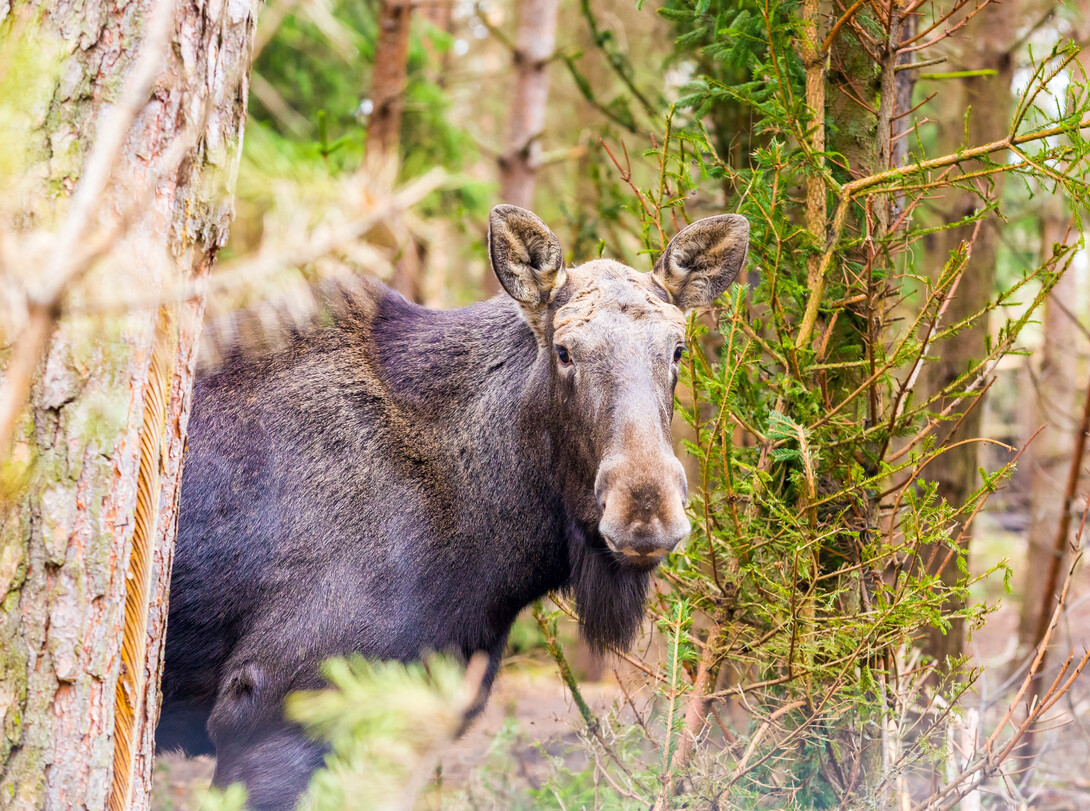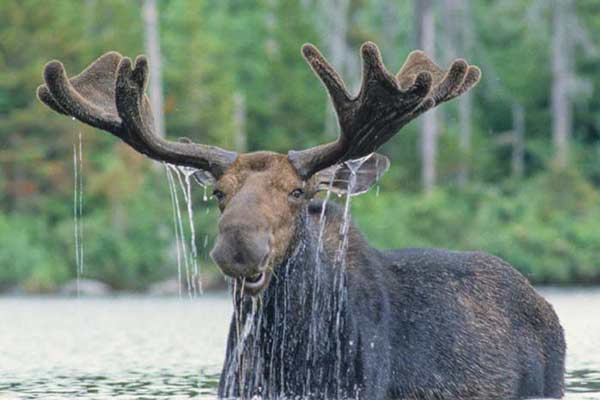Moose typically come out in the early morning or late afternoon to feed and graze. These large mammals are most active during these times to forage for food.
Moose, known for their impressive size and iconic antlers, are herbivores that primarily feed on aquatic plants, shrubs, and twigs. They emerge from dense forests or marshy areas to seek out their preferred vegetation. In regions where moose are prevalent, such as North America and parts of Europe and Asia, sightings of these majestic animals are common during the cooler hours of the day.
If you’re hoping to catch a glimpse of a moose in the wild, your best bet is to keep an eye out during the early morning or late afternoon hours when they are most active. Understanding their behavior and feeding patterns can increase your chances of encountering these graceful giants in their natural habitat.
Moose Behavior
Understanding moose behavior is crucial to spotting these majestic animals in the wild. From mating season to feeding habits, moose exhibit intriguing behaviors that define their lifestyle.
Mating Season
Moose mating season occurs in the fall, typically between September and October, when bull moose actively compete for females by displaying dominance through vocalization and physical battles.
Feeding Habits
Moose are herbivores with a diet primarily consisting of aquatic plants, twigs, and leaves. Their feeding habits change with the seasons, with a preference for aquatic vegetation in the summer and woody plants in the winter.

Credit: northernontario.travel
Environmental Factors
Environmental Factors: Moose activity is influenced by various factors. Let’s explore how weather conditions and seasonal changes impact when moose come out.
Weather Conditions
Temperature: Moose prefer cooler temperatures, coming out more in early mornings and evenings when it’s cooler.
Precipitation: Heavy rain may keep moose concealed in dense vegetation, while they may come out after a light rain.
Seasonal Changes
Spring: Moose come out more during spring to forage on new growth and find mates.
Summer: They may be less active during hot summer days, choosing to move around more during cooler nights.
Fall: Moose are more active in the fall as they prepare for winter by feeding heavily.
Best Time Of Day
When it comes to spotting moose, understanding the best time of day to catch a glimpse of these magnificent creatures can significantly increase your chances. Moose are most active during the morning and evening, making these times of day ideal for moose watching. Here’s a closer look at the best times to spot moose in the wild.
Morning
In the early hours of the morning, moose are often grazing in open areas such as meadows and along the edges of wooded areas. This makes it an optimal time to venture out and try your luck at spotting these majestic animals. Keep your distance and use binoculars for a safer and more rewarding experience.
Evening
As the day winds down, moose become more active once again. They can be found moving from feeding areas to resting spots, presenting another great opportunity to observe them in their natural habitat. Head out before dusk to maximize your chances of crossing paths with these incredible creatures.

Credit: www.northernoutdoors.com
Ideal Locations
When it comes to spotting moose in their natural habitat, knowing where to look is key. Moose are known to frequent specific types of environments that provide them with the resources they need to thrive. Below, we’ll explore two ideal locations where you have the best chances of encountering these magnificent creatures: forested areas and marshy areas.
Forested Areas
If you are eager to witness moose in their element, you’ll want to head to forested areas. These expansive and dense woodlands provide ideal shelter and ample food sources for moose, making them a preferred location for these majestic animals.
When exploring forested areas, keep in mind that moose are most active early in the morning and late in the afternoon. These are the times when they emerge from their hiding spots to graze on tender vegetation or search for water sources to quench their thirst.
To increase your chances of spotting a moose in a forested area, follow these tips:
- Look for signs of moose activity such as tracks and droppings.
- Stay quiet and move slowly to avoid startling the moose.
- Choose hiking trails that pass through moose habitats.
Marshy Areas
Another prime location to spot moose is in marshy areas. These wetlands provide moose with the necessary water for hydration and a diverse range of vegetation to feed on, including aquatic plants and shrubs.
Moose are adaptable animals, thriving in the challenging wetland conditions that many other creatures struggle to survive in. So, when planning your moose-watching adventure, consider visiting marshy areas such as bogs, swamps, and marshes.
Here are a few additional tips for spotting moose in marshy areas:
- Scan the horizon for moose silhouettes against the backdrop of open water.
- Monitor areas where moose might enter or exit the water.
- Be patient and observe from a distance to minimize disturbance.
Remember that moose are wild animals, and it’s essential to respect their space and observe them from a safe distance. By visiting forested areas and marshy areas known to be frequented by moose, you’ll increase your chances of encountering these magnificent creatures in their natural habitats.
Tips For Moose Watching
When it comes to moose watching, it’s important to have a few tips up your sleeve to increase your chances of spotting these majestic creatures. The key is to remain as silent and patient as possible, while also prioritizing your safety. In this article, we will explore some essential tips for moose watching to help you have a successful and enjoyable experience.
Silence And Patience
When observing moose in their natural habitat, silence and patience are your greatest allies. These gentle giants are easily startled by loud noises and sudden movements, so it’s crucial to minimize any disturbances that could cause them to retreat. Take the time to find a quiet and secluded spot where you can remain undetected.
An important aspect of maintaining silence is to avoid talking loudly or making unnecessary sounds. Instead, communicate with hand signals or use whispered voices when absolutely necessary. Keeping noise to a minimum will allow you to blend in with the surroundings and increase your chances of observing the moose in their unaltered behavior.
Additionally, practicing patience is key during moose watching. It’s important to understand that these animals are unpredictable and may not appear immediately. Moose tend to be more active during dusk and dawn, so plan your visit accordingly. Once you have settled into your observation spot, take deep breaths and focus on the present moment, fully immersing yourself in the natural beauty around you. Remember, patience is often rewarded with incredible wildlife sightings.
Safety Precautions
While enjoying the thrill of moose watching, it’s essential to prioritize your safety. These animals may appear gentle, but they are still wild creatures and should be respected as such. Here are a few safety precautions to keep in mind:
- Maintain a safe distance: Moose have powerful legs and can be surprisingly quick. It is recommended to stay at least 50 feet away from them to avoid provoking any defensive behavior.
- Observe from a hidden spot: Position yourself behind trees, bushes, or natural cover to remain hidden from the moose’s line of sight. This will minimize any potential threat perception.
- Never approach a moose: Despite their seemingly calm demeanor, moose can become aggressive if they feel threatened. It is crucial to never attempt to approach or touch them, no matter how tempting it may be.
- Keep dogs leashed and under control: Moose can view dogs as predators, which may trigger an aggressive response. Always keep your canine companion on a leash and under control when moose watching.
- Respect their space: Avoid invading the moose’s territory by keeping a safe distance and refraining from blocking their natural paths or feeding areas.
By following these safety precautions, you can ensure a respectful and secure experience while observing moose in their habitat. Safety should always be your top priority, allowing both you and the moose to coexist peacefully.

Credit: www.facebook.com
Frequently Asked Questions Of When Do Moose Come Out
When Do Moose Come Out Of Their Hiding?
Moose typically come out of their hiding during the early morning or late afternoon to graze on vegetation in open areas. They are most active during the cooler hours of the day and may retreat to the shade or cover of forests during the hottest parts of the day.
What Season Is Best To Spot Moose In The Wild?
The best season to spot moose in the wild is during the fall, specifically the months of September and October. This is when moose are in their rutting season, and the males are more active and vocal as they compete for mates.
It’s also a time when moose are more likely to venture out into more open areas.
Where Do Moose Go During The Winter?
During the winter, moose prefer to stay in areas with deep snow, as it provides insulation and protection from predators. They will often seek shelter in dense forests, where they can find food such as twigs, bark, and evergreen needles.
Moose are well adapted to cold weather and can withstand temperatures as low as -40 degrees Fahrenheit.
Conclusion
Understanding the behavior of moose is essential for wildlife enthusiasts and outdoor adventurers alike. Knowing when moose come out allows people to experience nature at its finest while staying safe. By respecting their habitat and observing from a distance, we can appreciate these magnificent creatures without disrupting their natural routines.



